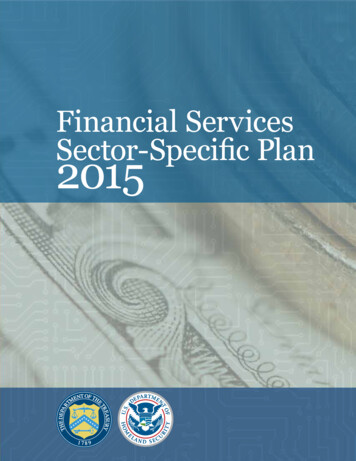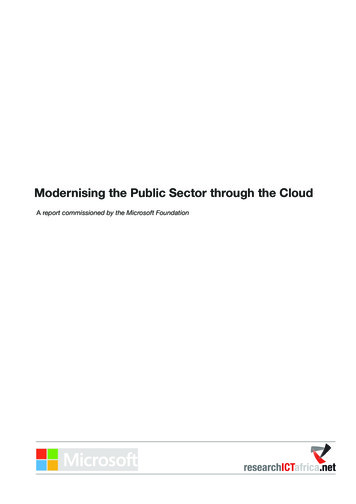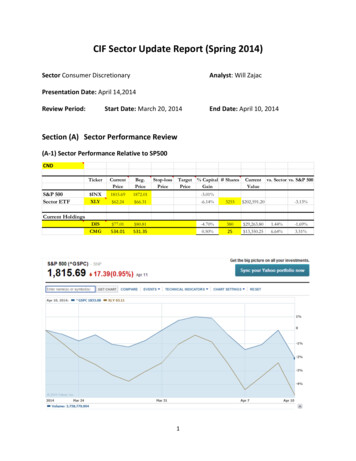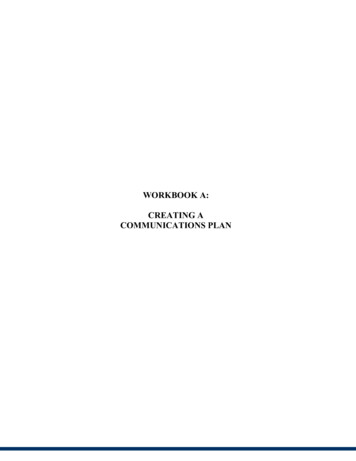
Transcription
CommunicationsSector-Specific PlanAn Annex to the NIPP 20132015
Table of ContentsLetter from the Council Chairs . iiiExecutive Summary.iv1. Introduction . 12. Sector Overview . 32.1Sector Risks .72.2Critical Infrastructure Partners .103. Vision, Goals, and Priorities . 134. Achieving Sector Goals . 164.1Risk Management .164.2Research & Development .224.3Critical Infrastructure and National Preparedness .225. Measuring Effectiveness . 255.1Sector Objectives .255.2Measurement Approach .26Appendix A: List of Acronyms and Abbreviations . 30Figures2-1:Communications Sector Architecture Model .52-2:Communications Sector Partnership Model .114-1:Communications Sector’s Risk Assessment History .174-2:Communications Sector Approach to Risk Reduction .184-3:NIPP 2013 Critical Infrastructure Risk Management Framework .19Tables3-1:Communications Sector Goals and Priorities .143-2:Communications Joint Sector Priorities Aligned to Joint National Priorities and NIPP 2013 Goals .154-1:Communications Sector Critical Dependencies and Mitigations for Dependencies .215-1:Communications Sector Priorities and Objectives.265-2:Communications Sector Priorities and Objectives aligned to the NIPP 2013 Calls to Action .29Communications Sector-Specific Plan 2015ii
LETTER FROM THE COUNCIL CHAIRSThe Department of Homeland Security designed this Communications Sector-Specific Plan (CSSP) to guide thesector's voluntary, collaborative efforts to improve security and resilience over the next four years. The CSSPdescribes how the Co mmunications Sector manages risks and contributes to national critical infrastructuresecurity and resilience, as set forth in Presidential Policy Directive 21. As an annex to the National InfrastructureProtection Plan 2013: Partnering for Critical Infrastructure Security and Resilience IPP 2013), this CSSPtailors the strategic guidance provided in the NIPP 2013 to the unique operating conditions and risk landscape ofthe Communications Sector. The sector strategy closely aligns with the NIPP 2013 national strategy, the 2014Joint National Priorities, and Executive Order (EO) 13636, Improving Critical Infrastructure Cybersecurity.This 2015 release of the CSSP serves as an update to the original plan issued in 2010. As with the previous plan,this CSSP represents a collaborative effort among the private sector; State, local, tribal, and territorialgovernments; nongovernmental organizations; and Federal departments and agencies to identify and work towardshared goals and priorities to reduce critical infrastructure risk.The Communications Sector Coordinating Council (CSCC) and Communications Sector GovernmentCoordinating Council (CGCC) jointly developed the Communications Sector goals, objectives, and activities inthis CSSP, which collectively reflect the overall strategic direction for the sector as a whole.This CSSP also reflects the maturation of the Communications Sector partnership and the progress made toaddress the evolving risk, operating, and policy environments. Since 2010, Communications Sector partners in thepublic and private sectors have taken significant steps to reduce sector risk, improve coordination, and strengthensecurity and resilience capabilities.In the same shared purpose that guided these actions and their support for the framework, concepts, and processesoutlined in the NIPP 2013 and EO 13636, Communications Sector partners look forward to continuing theirefforts to enhance the security and resilience of our Nation's critical infrasKathryn CondelloChairCommunications Sector, Sector Coordinating CouncilAndy OzmentlAssistant Seer ar ,CommunicationsU.S. Department of Homeland SecurityCaitlin DurkovichAssistant Secretary, Office of Infrastructure ProtectionU.S. Department of Homeland SecurityCommunications Sector-Specific PIan 2015iii
EXECUTIVE SUMMARYThe Communications Sector is an integral component of the U.S. economy, underlying the operations of allbusinesses, public safety organizations, and government. Over the last 25 years, the sector has evolved frompredominantly a provider of voice services into a diverse, competitive, and interconnected industry, usingterrestrial, satellite, and wireless transmission systems. The private sector, as owners and operators of the majorityof communications infrastructure, is the primary entity responsible for protecting sector infrastructure and assets.Working with the Federal Government, the private sector is able to predict, anticipate, and respond to sectoroutages and understand how they might affect the ability of the national leadership to communicate during timesof crisis, impact the operations of other sectors, and affect response and recovery efforts.As such, the Communications Sector Coordinating Council (CSCC) and Communications Sector GovernmentCoordinating Council (CGCC) worked collaboratively to develop an update to the 2010 Communications SectorSpecific Plan (CSSP) in accordance with the National Infrastructure Protection Plan 2013: Partnering forCritical Infrastructure Security and Resilience (NIPP 2013). In this 2015 CSSP, the CSCC and CGCC developedjoint goals that the sector will pursue to guide the mission over the next four years: (1) Protect and enhance theoverall physical and logical health of communications; (2) Rapidly reconstitute critical communications servicesin the event of disruption and mitigate cascading effects; and (3) Improve the sector’s national security andemergency preparedness (NS/EP) posture with Federal, State, local, tribal, international, and private sectorentities to reduce risk. To achieve these goals, the sector developed associated priorities to focus their efforts. Thegraphic below shows how the sector goals align to the joint sector priorities.Table ES-1: Communications Sector Goals and PrioritiesCommunications Sector-Specific Plan 2015iv
This updated CSSP will guide security and resilience efforts, inform partner decisions, and improve riskmanagement practices over the next four years. As a part of this 2015 CSSP, the CSCC and CGCC have identifiedsector-specific risks and interdependencies. Consistent with the NIPP 2013 Critical Infrastructure RiskManagement Framework, the Communications Sector’s approach to network defense prioritizes assets, assessesthreats and vulnerabilities, and then uses the findings of these assessments as criteria to focus resources ondefenses that yield optimal protection. The Communications Sector regularly undertakes risk assessments toaddress evolving issues by topic, segment, or threat. Across the Communications Sector, industry and governmentpartners collaborate to conduct risk assessments as an ongoing activity, with the intent to maintain a nationalcommunications infrastructure that is resilient, diverse, redundant, and recoverable.The vision, goals, and joint sector priorities contained in the 2015 CSSP demonstrate how the sector iscontributing towards the advancement of the NIPP 2013 Goals and the Joint National Priorities established by theNIPP Call to Action (CtA) #1, which advocated for the development of joint national priorities to inform resourceallocation and decision-making on the part of critical infrastructure partners.In order to implement this CSSP, the Communications Sector partners developed a set of broad objectives alignedto the four sector priorities that will contribute to sector goals and priorities. Details on the sector’s objectives arein Chapter Five, Measuring Effectiveness, which includes both voluntary partnership activities and tasks thesector may pursue on its own volition.The Communications Sector will leverage the NIPP 2013 CtA categories to track and report, on a quarterly basis,the progress of sector activities to DHS’s Office of Infrastructure Protection. The NIPP 2013’s CtA guides effortsto achieve national goals and, therefore, to enhance national critical infrastructure security and resilience. TheNIPP 2013 CtA will serve as a roadmap to ensure continuous improvement of security and resilience through theCommunications Sector’s efforts.This update also reflects the maturation of the Communications Sector partnerships and the progress made toaddress the evolving risk, operating, and policy environments.Communications Sector-Specific Plan 2015v
1. INTRODUCTIONThis Communications Sector-Specific Plan (CSSP) is an update to the sector’s 2010 Sector-Specific Plan (SSP) inaccordance with the National Infrastructure Protection Plan 2013: Partnering for Critical Infrastructure Securityand Resilience (NIPP 2013).1 The NIPP 2013 establishes a set of broad critical infrastructure security andresilience national goals, which the sector-specific priorities and planned activities outlined in this CSSP support.This update tailors the strategic guidance provided in the NIPP 2013 to the unique operating conditions and risklandscape of the Communications Sector.Since 2010, the Communications Sector has evolved rapidly in multiple areas, including mobile broadband, cloudcomputing, the Internet of Things (IoT), and software-defined networks (SDNs). Voice and data networks havecontinued to converge, and mobile devices, such as smartphones and tablet computers, have been widely adopted,creating enormous demand for mobile broadband communications. These changes increase the requirement forimproved sector security and resilience, which the CSSP seeks to address by setting the strategic direction forvoluntary, collaborative efforts to improve sector security and resilience over the next four years. It describes howthe Communications Sector manages risks and contributes to national critical infrastructure security andresilience, as set forth in Presidential Policy Directive 21: Critical Infrastructure Security and Resilience. As such,the sector strategy supports the NIPP 2013 national goals and strategy, the 2014 Joint National Priorities,implementation of Executive Order 13636: Improving Critical Infrastructure Cybersecurity, and the NIPP 2013Call to Action (CtA) #2.2This update also answers NIPP 2013 CtA #2, which calls upon each sector to update its SSP every four years toreflect joint priorities, address sector reliance on lifeline functions, describe national preparedness efforts, outlinecybersecurity efforts, and develop metrics to measure progress. The Vision, Goals, and Priorities Section of thisdocument illustrates how the Communications Sector’s priorities support both the NIPP 2013 national goals andJoint National Priorities. Public and private-sector representatives have identified shared goals and priorities, anda supporting set of collaborative activities they plan to pursue during the next four years.This CSSP includes: Sector Overview—Provides a concise profile of the sector’s evolution since 2010, characteristics, riskprofile, and key public and private-sector partners and venues.Vision, Goals, and Priorities—Presents the sector’s mission and updates goals and priorities forcommunications security and resilience over the next four years.Achieving Sector Goals—Describes mechanisms to achieve sector goals, including ongoing and plannedpartnership programs, activities, and resources that support the sector’s current risk management1Communications Sector-Specific Plan: An Annex to the National Infrastructure Protection Plan, 2010 is available at thefollowing URL: ions-2010. Accessed December 2, 2015.2The NIPP 2013’s CtA guides the private sector and Federal, State, local, tribal, territorial, and regional government effortsin implementing the NIPP, which has 12 actions assigned to three categories.Communications Sector-Specific Plan 20151
approach; research and development (R&D) priorities; and how the sector supports national preparednessthrough incident response and recovery.Measuring Effectiveness—Provides the list of initiatives that the CSCC and CGCC will undertake inpartnership to address sector priorities, as well as the approach the sector will use to measure theeffectiveness of individual activities.The CSSP provides targets for Communications Sector public and private partner collaboration, specificallyamong government agencies, private industry, and DHS’s Office of Cybersecurity and Communications (CS&C),which serves as the Sector-Specific Agency (SSA) for the Communications Sector. Partners have a clear andshared interest in ensuring the security and resilience of critical sector assets, and this plan represents thevoluntary, collaborative activities that have the greatest effect on reducing sector risk and building resilience.Communications Sector-Specific Plan 20152
2. SECTOR OVERVIEWThe Communications Sector provides products and services that support the efficient operation of today’s globalinformation-based society.3 In 2014, information and communication technology (ICT) companies accounted for3.5 million jobs, contributing about 1 trillion to the U.S. gross domestic product (GDP) through both direct andindirect contributions, which is about 7 percent of the U.S. economy.4 Many of these products and services arefoundational or necessary for the operations and services provided by other critical infrastructure sectors. Thesector recognizes that other sectors consider its services to be critical, and its practices reflect this understanding.The nature of communication networks involve both physical infrastructure (buildings, switches, towers,antennas, etc.) and cyber infrastructure (routing and switching software, operational support systems, userapplications, etc.), representing a holistic challenge to address the entire physical-cyber infrastructure. The resulthas been the establishment of a robust, resilient network infrastructure that successfully provides servicesglobally.Virtually every element of modern life is now dependent on cyber infrastructure. As a result, our Nation’seconomic and national security relies on the security of the assets and operations of critical communicationsinfrastructure. Past terrorist attacks and catastrophic natural disasters emphasized the need to focus our nationalattention on protecting the Nation’s critical infrastructure and making it more resilient. Moving forward, it isessential that public and private sector partners adopt a coordinated approach to achieve joint goals for ourcommunications infrastructure.The public sector—Federal, State, and local governments—and the private sector share the responsibility forsecuring the Nation’s critical communications infrastructure. Sector partners benefit from complementary skillsets, expertise, and individual resources to meet their shared responsibility for addressing all-hazard threats.The individuals and organizations that contribute to the planning of initiatives to keep the Nation’scommunication networks resilient enough to withstand natural and manmade disasters, as well as thoseresponsible for responding and restoring those networks post-event, have partnered to update this CSSP from its2010 version. These include representatives from the five segments of the Communications Sector: broadcasting,cable, satellite, wireless, and wireline.Key Sector CharacteristicsCommunication networks enable people around the world to contact one another, access information instantly,and communicate from remote areas. This involves creating a link between a sender (including voice signals) andone or more recipients using technology (e.g., a telephone system or the Internet) to transmit information fromone location to another. Technologies are changing at a rapid pace, increasing the number of products, services,3U.S. Department of Commerce Bureau of Economic Analysis is available at the following URL:http://bea.gov/iTable/iTable.cfm?ReqID 51&step 1#reqid 51&step 2&isuri 1. Accessed December 2, 2015.Telecommunications Industry Association’s TIA2014 Playbook is available at the following URL:http://www.tiaonline.org/PDF/9603 FinalProof LoRes.pdf. Accessed December 2, 2015.4Communications Sector-Specific Plan 20153
service providers, and communication options. The national communications architecture is a complex collectionof networks that are owned and operated by individual service providers, consisting of three main functionalareas: Services and Applications, Core Network, and the five segments’ Access Networks.Today, using more means than ever before, enormous volumes of information move at ever-faster speeds amongan ever-increasing number of users and machines. Over the past 25 years, the public switched telephone network(PSTN) in the United States has evolved from a largely mechanical, circuit-switched network carrying voicetelephone calls, which a few U.S. companies owned and operated, to a highly complex and integrated system ofcomputer-controlled, packet-based networks carrying voice, data, and video, which thousands of domestic andinternational organizations own. Reliance on established circuit-based switching for communication is rapidlywaning, and most of the traffic running over the public communication networks in 2014 was transmitted as datapackets. The Internet is not the only part of the public network (PN) experiencing rapid growth. According toCisco Systems, Inc., traffic from mobile data in 2013 was nearly 18 times the size of the entire Internet in 2000.55The Cisco Visual Networking Index Global Mobile Data Traffic Forecast Update is available at the following hite paper c11520862.html. Accessed December 2, 2015.Communications Sector-Specific Plan 20154
Figure 2-1: Communications Sector Architecture Model6As more devices connect to public communication networks, service firms can provide more types of devicespecific services over those networks. The Communications Sector architecture model in Figure 2-1 serves as arepresentation of the collective infrastructure, which illustrates at least five major ways to access the numerousvoice, video, and data services on the core network: broadcasting, cable, satellite, wireless, and wireline networks.Since 2010, the Communications Sector has continued to make rapid, technological advances in multiple areas,including network infrastructure, mobile broadband, cloud computing, IoT, Internet Protocol (IP) networks, Overthe-Top services (e.g., Voice over IP (VoIP)), and even SDNs. Network convergence has evolved alongsidetechnology, with all forms of broadband infrastructure investments occurring across the United States as serviceproviders have worked to meet individual and enterprise requirements for faster communication services.Smartphones, tablet computers, and their associated mobile applications emerged as rapidly adopted key usertechnologies in the Communications Sector, and their explosive growth has generated enormous demand formobile broadband. Enterprises have since embraced cloud computing with Platform as a Service, Infrastructure asa Service, and Software as a Service enjoying widespread adoption.7 Concurrently, the national policyenvironment has also evolved with the addition of Executive Order (EO) 13618, Assignment of National Security6This architecture model depicts examples of network access methods and services provided. It is not intended to becomprehensive, exact or authoritative (Source: 2012 National Sector Risk Assessment for Communications (NSRA)).7National Security Telecommunications Advisory Committee (NSTAC) Report to the President on Cloud Computing, May15, 2012Communications Sector-Specific Plan 20155
and Emergency Preparedness Communications Functions and EO 13636, Improving Critical InfrastructureCybersecurity.Key Sector ComponentsThe Communications Sector represents a large number of facilities and sites that differ based on function, size,operating principles, and security risks. The sector includes five component areas that have similar functions andoperations, thereby representing the access segments. The following section provides a brief overview of the fiveaccess segments for each component area.BroadcastBroadcasting systems consist of free and subscription based, over-the-air radio andtelevision (TV) stations that offer analog and digital audio and video programmingservices and data services. Broadcasting has been the principal means of providingemergency alert services to the public for six decades. Broadcasting systems operate inthree frequency bands: medium frequency (MF (AM radio)), very high frequency (VHF(FM radio and TV)), and ultra-high frequency (UHF (TV)). The full transition to digitalTV and ongoing transition to digital radio provide broadcast stations with enhancedcapabilities, including the ability to multicast multiple programs on a single channel.Radio and TV stations also stream broadcast and additional programming content overthe Internet.CableThe cable industry is composed of more than 7,700 cable systems that offer analog anddigital video programming services, digital telephone service, and high-speed broadbandservices. The cable systems use a mixture of fiber and coaxial cable to providebidirectional signal paths to the customer. This hybrid fiber/coaxial (HFC) networkarchitecture effectively segments the cable system into a number of parallel distributionnetworks. The HFC architecture is beneficial to business and residential customersbecause it improves signal performance and increases available bandwidth and overallnetwork reliability. Although network designs vary, the HFC architecture in anyparticular community is typically based on a three-level topology, which includes aheadend, one or more distribution hub(s), and multiple fiber nodes.SatelliteThis is a platform launched into orbit to relay voice, video, or data signals as part of atelecommunications network. Earth station antennas transmit signals to the satellite,which are amplified and sent back to Earth for reception by other earth station antennas.Satellites use a combination of terrestrial and space components to perform many typesof functions, such as the bidirectional transmission of voice, video, and data services;data collection; event detection; timing; and navigation.Communications Sector-Specific Plan 20156
WirelessWireless refers to telecommunication in which electromagnetic waves (rather than someform of wire) carry the signal over part of or the entire communication path. Wirelesstechnologies consist of cellular phones, wireless hot spots (WiFi), personalcommunication services, high-frequency radio, unlicensed wireless, and othercommercial and private radio services to provide communication services.WirelineConsists of circuit- and packet-switched networks via copper, fiber, and coaxial transportmedia. It includes private enterprise data and telephony networks, the core backbone ofthe Internet, and the PSTN.2.1 Sector RisksIn 2012, the Communications Sector undertook a comprehensive, all-hazards assessment of the current physical,cyber, and human risks faced by the domestic communication networks at the local, regional, and national levels. 8All these risks remain of concern today. Physical risks involve the impact of natural, such as Category 4 or 5hurricanes, major urban floods, major earthquakes, and solar super storms, or manmade events, such as terroristattacks, intentional electromagnetic interference and explosives, and accidents, such as submarine cable damage,on communications infrastructure. Cyber risks involve threats from both malicious and non-malicious actors,including resource exhaustion, system alteration, or damage to the white space frequency database (e.g., unusedspectrum). Human risks involve the impact of humans on network confidentiality, integrity, and availabilityacross multiple categories: access of communications personnel to a disaster area, security of personnel andequipment during response and recovery, employee security awareness, and internal and external threats.Depending on the specific physical, cyber, or human threat, the risk posed may be minimal or elevated in itsimpact on local, regional, or national communications.Communications Sector Risk ProfileNatural Disasters and Extreme WeatherHurricanes, wildfires, and other extreme weather events have increased in frequency andseverity in recent years, impacting local and regional communications infrastructure inthe United States. On a national level, a geomagnetic solar super storm, such as the onein July 2012, could cause an electromagnetic pulse that collapses electric power gridsand triggers a long-term outage (LTO) in national communications.98These risks were assessed in the 2012 NSRA.9Information about the July 2012 solar super storm is available at the following URL: a/2014/23jul superstorm/. Accessed December 2, 2015.Communications Sector-Specific Plan 20157
Supply Chain VulnerabilitiesThe Communications Sector depends on suppliers for the products and services that arenecessary to deliver communication services to users. In particular, the sector isdependent on reliable hardware and software. This is an area the sector continues toscrutinize closely.Global Political and Social ImplicationsThe Communications Sector is global with significant numbers of partners, suppliers,customers, employees, and facilities located outside the United States. As a result, thesector monitors geopolitical unrest, economic conditions, and other factors as they mayaffect distribution patterns, foreign operations, employees, or partners.Cyber VulnerabilitiesThe Internet is a complex ecosystem comprising suppliers, networks, and serviceproviders, all of whom are part of the Communications Sector. Any vulnerabilities orthreats to functions and capabilities outside of the Communications Sector (e.g.,hardware, software, and operating systems) have the potential to affect network providerservices and, therefore, require ongoing attention.Emerging Sector RisksA number of long-range strategic threats, as noted in DHS’s 2014 Quadrennial Homeland Security Review(QHSR), are emerging and include pandemic diseases, climate change, and aging critical infrastructure.10 Morerelevant emerging risks include risks to the Global Positioning System (GPS), risks associated with the IoT, andrisks associated with the need for rapid mobilization and coordination of critical commercial sector assets inresponse to a large-scale incident of national security concern.11,12,13Cross-Sector Dependencies and InterdependenciesThe NIPP 2013 identifies lifeline functions—which include communications, energy, transportation, andwater14—and resources essential to the operations of most critical infrastructure partners and communities.Identifying lifeline functions, specifically those that are interdependent with other sectors, can supportpreparedness planning and capability development. Communication dependencies include:102014 Quadrennial Homeland Security Review, June 18, 2014, pgs. 22-2311U.S. Government Accountability Office Report, GPS Disruptions: Efforts to Assess Risks to Critical Infrastructure andCoordinate Agency Actions Should Be Enhanced, November 201312NSTAC Report to the President on Information and Communications Technology Mobilization, November 19, 201413NSTAC Report to the President on the Internet of Things, November 19, 201414NIPP 2013, Partnering for Critical Infrastructure Security and Resilience, page 17Communications Sector-Specific Pla
This Communications Sector-Specific Plan (CSSP) is an update to the sector's 2010 Sector-Specific Plan (SSP) in accordance with the National Infrastructure Protection Plan 2013: Partnering for Critical Infrastructure Security and Resilience (NIPP 2013). 1 . The NIPP 2013 establishes a set of broad critical infrastructure security and










